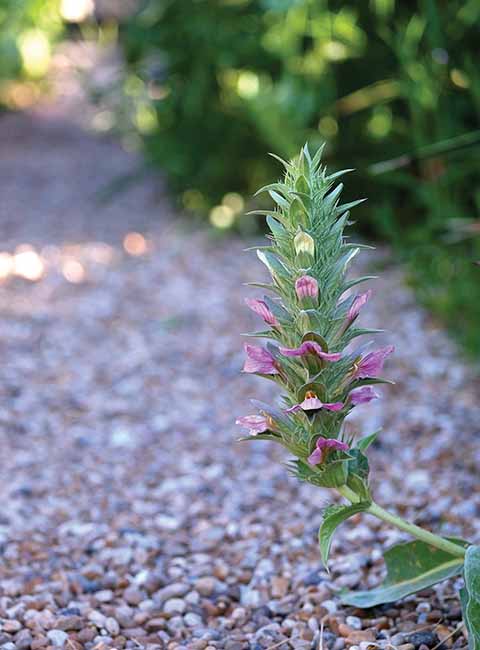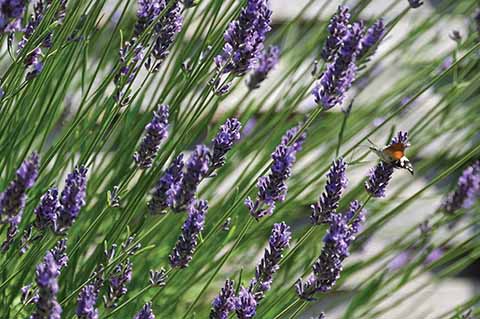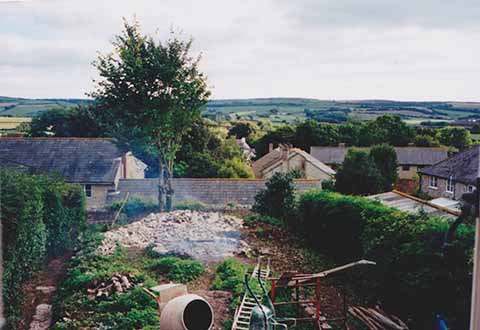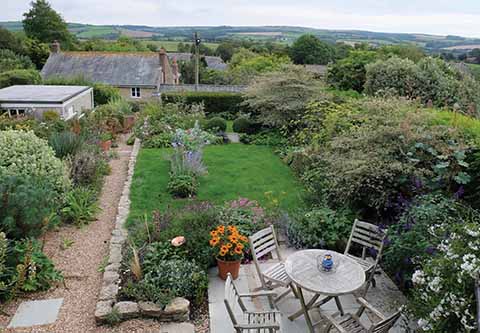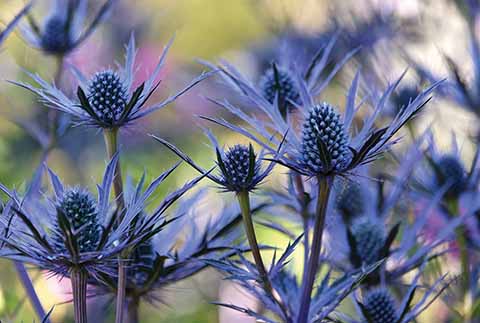Dorset Garden – The art of composing a garden
In the first of her articles about all things gardening, designer and horticulturist Pauline Caroline Jones talks about how she went about creating her own garden.
Published in November ’19
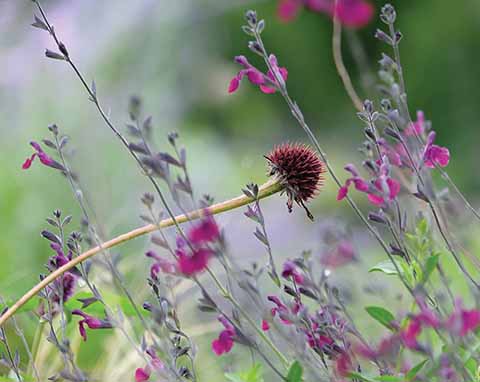
The perennial Salvia x jamensis ‘Nachtvlinder’ dies back to ground level each year, an example of nature and garden design co-existing
IT WAS A wonderfully balmy August bank holiday as I sat in the garden to write the introduction for this feature, while enjoying the fruits of high summer. Butterflies were flitting about, bees feasting on Salvia x jamensis ‘Nachtvlinder’ and birds scurrying around the undergrowth of the gravel border in search of tasty morsels.
This is an opportunity to spend quality time in the garden, trimming the yew, lavender and box hedges and cutting back selected perennials such as catmint and lady’s mantle to encourage a second flush of flowers. The latter always presents a bit of a quandary, as we like to invite wildlife into our little patch of paradise, so tend to leave architectural perennials – Echinops ritro ‘Veitch’s Blue’, Eryngium x zabelii and the like – until the bees have lost interest, then retain the seed-heads for the birds. And when this work is done, it’s time to let nature do its own thing for a while.
We bought our derelict little stone cottage at an auction in the autumn of 2000. I had just qualified as a garden designer after completing my studies at the renowned English Gardening School and after several years of renting we were looking for an opportunity to get back onto the property ladder. The cottage had been sadly neglected and from floor to ceiling was packed solidly with wood … yes, really! Outside, the only vegetation to speak of was an overgrown leylandii hedge and a lonely Acanthus mollis, which continues to flower profusely each year, a lovely reminder of where it all began. Once we had cleared the debris and after many smoky bonfires, we saw the potential of a bigger garden than first anticipated that opened up stunning views of the Bride Valley. These were wonderfully exciting times.
Initially, work on the garden proved to be a labour of love, as we discovered buried under the soil, amongst other things, sheets of broken glass, flint and endless rusty nails, so everything had to be done painstakingly by hand. The soil appeared to be devoid of nutrients or any sign of life other than an extremely large collection of snails. Challenges aside, we set about digging over the garden, adding lots of wormy organic matter to the inert, chalky soil. I recall working well into dusk and loving every minute of it.
Russell Page, the garden designers’ garden designer, said that the art of composing a garden ‘is a question first of selection and then of emphasis’. As a garden designer, part of my natural process is to have some design principles in place before throwing away the rule book. So I put my designer hat on and created structure in the form of hedges, climbers, specimen shrubs, a Himalayan silver birch and a Tibetan cherry tree, both of which sadly grew too large for their allocated space. The front garden has a south-facing aspect and strong winds whip up from the coast, but the biggest challenge has been the claggy, alkaline soil that we have learned to embrace by planting Mediterranean-style. A few perennials suffer from chlorosis early in the season but others, like olive trees and Russian sage, positively thrive under such conditions.
There have of course been setbacks over the years. One autumn the wind took down the boundary trellis, uprooting established climbers in its path. Then after a particularly warm, wet winter we encountered box blight, which is just soul-destroying. So I refrained from clipping for a couple of years to improve air circulation around the hedges and it made a good recovery – for the time being anyway.
I decided on a cool colour scheme using shades of blue, purple, white and pink that sit well within the landscape, with an occasional shock of burnt orange for contrast. This is essentially a perennial garden with quite unusual specimens like the very pretty Acanthus dioscoridis, which I bought from a specialist nursery. In spring, brightly coloured tulips clash artistically with the acid green of Euphorbia characias subsp. wulfenii, against the backdrop of Clematis montana var. grandiflora. Later alliums and Sicilian honey garlic, a subtle beauty with elegantly nodding bells of antique rose, cream and soft green, take centre stage.
In summer, lavender attracts the welcome arrival of the hummingbird hawk moth and in the evenings the bats flit through the warm air. Sea mist in the valley and morning dew herald the start of autumn, a time when ornamental grasses and seed heads come into their own, and in the winter months, when many perennials have died back and leaves have fallen, the structure of the garden returns.
The back garden is cut deeply into a hill and lies on a solid chalk fault. The obvious solution here was to have it terraced and we decided to make it a kitchen garden. The stone wall provides shelter and, despite being north-facing, herbs such as rosemary, bay, cotton lavender, oregano, marjoram and mint grow quite happily, while the productive area is situated at the top end of the terrace, taking full advantage of the afternoon sun.
Tomatoes have been abundantly delicious, growing outside in hay bales for warmth. We choose small, cherry varieties as they have a better chance of ripening. The fanned fruit trees that form the back boundary have for some reason not been a huge success, but all is not lost as the birds enjoy the little fruit that they produce. Pumpkins and courgettes trail across the terrace with gay abandon and every summer the patch becomes over-run with self-seeded nasturtium. I’m sure that there is a recipe somewhere for nasturtium pesto.
It’s fair to say that I love my garden, as it evolves with nature and becomes ever more beautiful. From the early days of being quite controlled, I now leave much of it to wildlife and it is an absolute delight, even more so when it is captured through the lens of a camera.
As you read this, it will be time to finish planting up spring bulbs and start planning for next year and that will be the subject for the January 2020 issue. I will be sharing garden design tricks of the trade and showing examples of how they work in gardens in Dorset, some of which you can visit. Until then, enjoy your garden.
Pauline Caroline Jones is a garden designer and lecturer and is currently running courses at the Arts University Bournemouth. In future issues, she will visit other inspirational gardens, sharing how fellow gardeners cope with the inevitable challenges involved with their own unique plot of Dorset soil and profile specific plants of interest.
www.paperwhitegardendesign.co.uk
